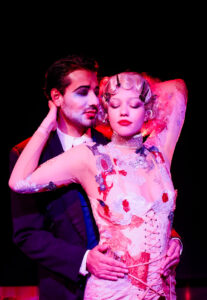URBANA — Prohibition-Era decadence dominates the stage in Andrew Lippa’s musical “The Wild Party,” as attendees flirt, dance and fight in a debaucherous celebration hosted by the tempestuous couple Queenie and Burrs.
IPM reporter Owen Henderson spoke with Danny Yoerges and Rachel Rizzuto, the husband and wife team directing the show, about Lyric Theatre at Illinois’ upcoming production.
Catch “The Wild Party” on Nov. 7th, 9th, and 10th at the Krannert Center for Performing Arts.
OWEN HENDERSON: If I understand correctly, this is the first mainstage show that either of you have directed with Krannert.

RACHEL RIZZUTO: That is absolutely correct.
DANNY YOERGES: That’s true.
HENDERSON: What have your experiences been like directing this together?
YOERGES: Directing it together has been great, if not hectic.
RIZZUTO: I think this is one of the more choreography and just-staging-heavy shows that Lyric Theatre has done in a while.
HENDERSON: Your background is in dance, Rachel, and I was curious what that has brought to your sensibilities, not just as a choreographer, but also as a director.
RIZZUTO: We want to keep this show in the realm of reality. So both of us were not interested in creating a show where there is necessarily, “Let’s stop and do a musical theater number for the audience,” and more about what kind of dancing would actually ensue at a debaucherous, drunken, drug-fueled party. So a lot of the movement we kept rooted in social dance. Some of it is period-esque, since it is set in the 1920s,
YOERGES: When we first started working on this, Rachel mentioned that she wanted the movement to somehow resemble the feel of being at a party of our mutual friend back in New York, who was Rachel’s choreographer and her dance company. Most people might not know that modern dancers in social dance situations do really weird stuff. So it is social dance with a modern dance flair.
The way that the actors are moving in a lot of the scenes is incredibly abstract and ethereal, and we were really interested in presenting scenes of sexuality and sexual violence, and just plain old violence in an interpretive movement way as opposed to a literal way. The themes are there. And it’s important that we address them and that they’re a part of the message of this show.
And I think that by abstracting a lot of the violence and sexual violence and sex in the show, we’re actually telling a more compelling and interesting story that people can relate to, from a number of different perspectives, without necessarily having to relive their own personal trauma, whether as performers or audience members.
HENDERSON: The show originally ran off-Broadway in 1999. It’s based on source material from the 1920s. And so I was curious what the conversations have been like with the cast, thinking about putting things in context appropriately. But also, how much of that can you look at with the lens of where we are now in 2023?
YOERGES: Well, what’s so interesting about it, to me is that it was written during the Prohibition, when suddenly, you know, the majority of Americans drinking Americans found themselves on the wrong side of the law. There was a sense in the 20s, of just freedom. And so people were expressing themselves in ways that they just had not done before.

So for there to be a character that is an unapologetic lesbian as a main character in this story, written in 1926, but not published until 1928 because it was deemed too risque… We have to approach the same thing that was white-hot exciting in the 1920s, more normalized in the 1990s, and then now has come full circle to being like, “Okay, how can we represent gay people and people of color without making that their only attribute.”
And it’s challenging because that’s sort of what the musical is doing. It’s highlighting these attributes, and making them the most important thing, but the audience is just, they’re not even gonna blink at it, they’re gonna be like, “So what?”
RIZZUTO: Remaining true to what the actual storyline is, and the way that these characters what their, what their arcs are within the show, while still, as Danny said, trying to give them fully dimensional, fully fleshed out character arcs… It is a challenge.
YOERGES: If you read the original poem, it is unequivocal in casting all of the people at this party as being bad people, that they are all sinful, greedy, looking out for themselves and for what’s going to satisfy them at this party. Why is that something that has been a part of society since time immemorial? I think it’s a question of human nature.
RIZZUTO: It does give us freedom, though, as directors to think about these characters in more dimensions than just what’s written on the page and the stereotypical like bad or predatory qualities of some of them. We’re thinking of them all, I think, as flawed characters, yes. But we’re finding more than that about them.

